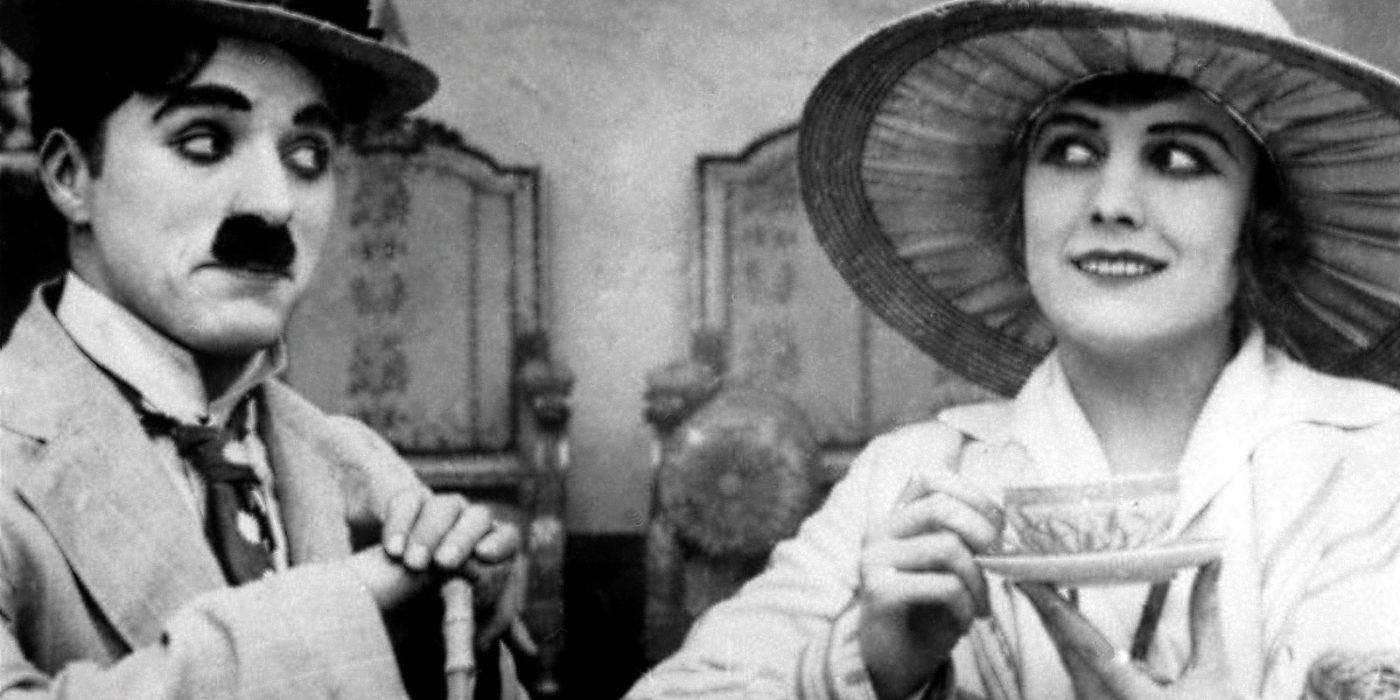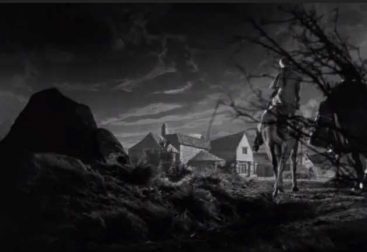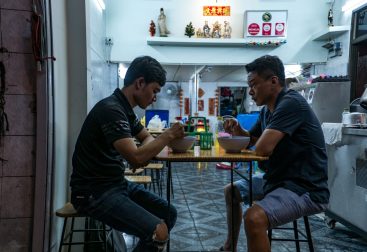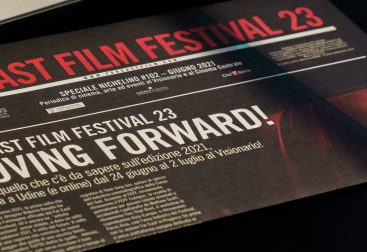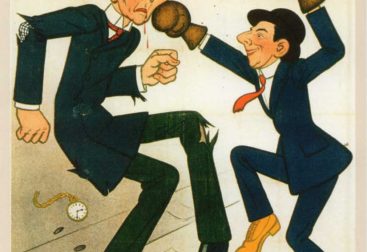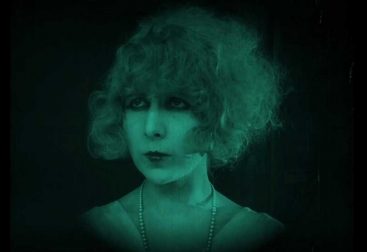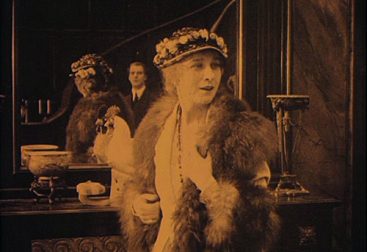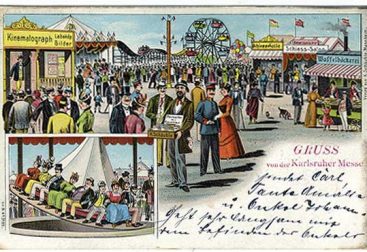First Part
2 months before the start of the 19th Karlsruhe Silent Film Festival
At the end of November/beginning of December 2021, the expected course of the pandemic situation was more or less unclear. But we had to make a decision in our small team as to whether we wanted to organize the silent film festival. In the course of December, my personal opinion and that of the team solidified, to organize the festival in any case and only to cancel it if the implementation should no longer be possible due to a regulation of the state government of Baden-Württemberg.
I communicated this internally to the members of the festival’s supporting association and also to the many hundreds of people who received our newsletter; finally also by press release to the local newspaper and other regional and national media. Advertisements had appeared in the local monthly magazines anyway.
An important decision had to be made for the editors of the program brochure, which is usually published in two languages. The ultimately uncertain situation led to the decision to only publish the program brochure in one language in order not to have increased the costs unnecessarily in the event of a cancellation at short notice.
Editing the program brochure requires a relatively large amount of time; and more than a week is also needed for printing and delivery. So the decision had to be made early in December.
Beginning of January 2022
The pandemic situation and the statements made by the responsible members of the government or institutes make the possibility of a lockdown increasingly unlikely.
After the end of the Christmas holidays and after a meeting of the key bodies in Berlin on January 9th, it can definitely be decided that the festival can take place from January 26th to 30th, 2022.
The program brochure goes to press on January 11; A further delay does not seem advisable to me because the printers themselves were unable to meet the delivery date when printing the leaflet for the first time in many years, and the delivery was delayed. The reason for this remained unclear: lack of paper or high levels of sick leave and staff shortages?
On January 15th, 11 days before the festival, I write a newsletter that a lockdown is no longer to be expected and that the festival can definitely take place.
The time after the program brochure has been printed usually brings me a short recovery phase, because at this time all the films have been ordered, the hotel is reserved for the musicians and other invited guests and, at best, there are still a few organizational things to be settled.
This year, however, these details are growing into problems, as we are in a room that we have never used; There is neither sound nor projection technology in this room, and finally the pandemic situation and the applicable rules make further organizational measures necessary.
An orchestra, which is constantly rehearsing in the Festhalle Durlach, is not very helpful when it has to be clarified how the relatively small Kaps grand piano is to be lifted down from the stage into the hall.
I get an email with a press article stating that a person got himself killed by a concert grand piano while trying to transport a 400kg grand piano alone. I don’t want a similar fate to happen to me, so I commission a freight forwarder with the task of moving the grand piano about 80 cm from the stage into the hall.
For the percussionist, who will accompany the opening film with the project ensemble Déjà Vu under the direction of Gabriel Thibaudeau, a drum kit has to be rented because you cannot take a drum kit as hand luggage on the TGV from Paris to Karlsruhe. After a few small problems of understanding, it all works smoothly and to the great satisfaction of the percussionist.
However, it takes more time than I could have imagined before I find a suitable plexiglass shield to protect the checkout staff and it gets on my nerves. In a DIY store in Karlsruhe, as someone advised me, I can’t find anything, not even in a specialized Karlsruhe glazier’s shop that only produces to order and has a delivery time of 14 days, so I have to assume that the price would then be set as if I had a tailor make a tailor-made suit, so it takes a lot more time than planned. … Finally, in the vastness of the Internet, I find a company in the Netherlands (!) that delivers quickly and relatively inexpensively. When ordering, I give the address of the Festhalle Durlach for delivery. The spit protecting shiel is scheduled to arrive on the 26th, the day the festival opens. Let’s see …
Tuesday 25 January 2022: One day before the festival –
I write an email to the members of the festival’s supporting association with the very clear sentence: “Most of the problems have been solved.”
The grand piano is in the hall and is tuned; the Durlach city office has received the hygiene concept, which is several pages long; I have installed the software on my mobile phone with which the vaccination and test certificates of the visitors can be scanned.
During the day, the musicians of the ensemble that will accompany Ernst Lubitsch’s “The Marriage Circle” at the opening of the festival arrived and have moved into their hotel. My colleague and associate festival director Maria Adorno has also arrived in Karlsruhe.
The eve of the festival:
We all meet for dinner at the “Rosa Bianca” restaurant. The mood is good, I’m glad that everything seems to have been settled so far. Only our cinema technician, who should actually be there by now, is still on the highway and doesn’t get to dinner in time. And Jean Michel Davis, who was only able to leave Paris in the afternoon because of another commitment, has a taxi drive him directly from the train station to the restaurant.
I once described the “Rosa Bianca” as an Italian restaurant with a German style, and Maria’s father agreed with my assessment. In Italy there are almost never sauces with meat or fish – in the “Rosa Bianca” there are. Only the white wine from Piedmont that we drink is purely Italian: the Arneis, which I really appreciate.
Conversation, as usual, is multilingual. We switch from French to English, back and forth, occasionally Italian is also spoken, and the German-speaking participants chatter in German.
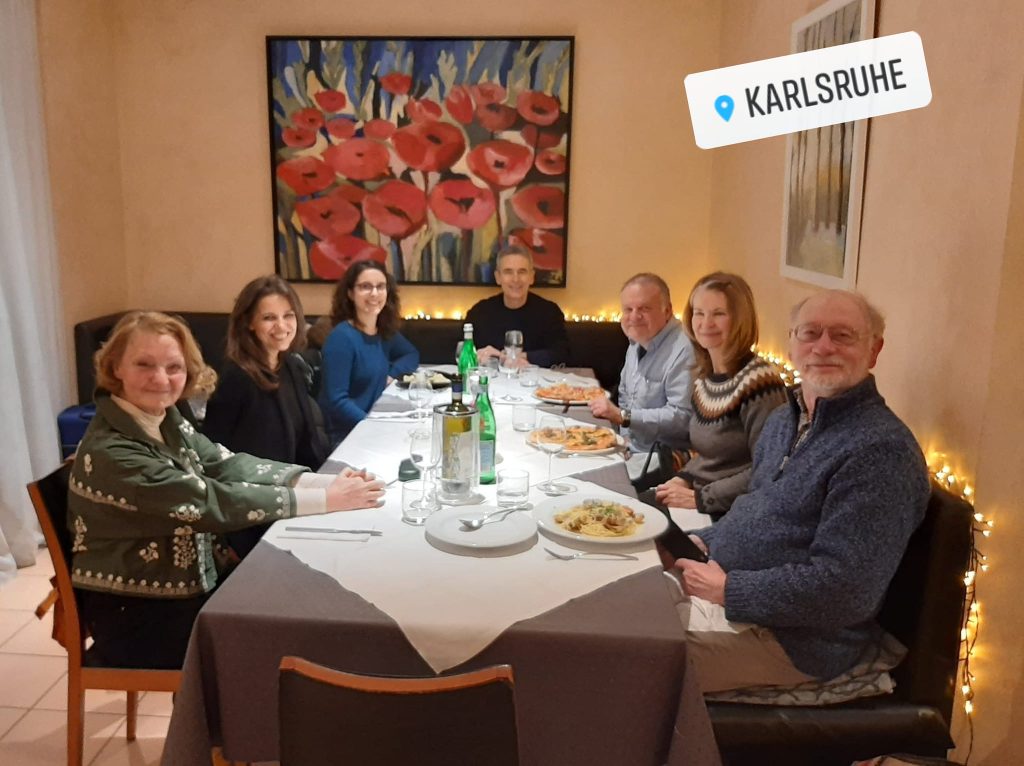
Wednesday, January 26, 2022 – First day of the festival – Opening
Our cinema technician, Jens Göldner, has ordered his helpers for 8 a.m., I intend to come later. However, I have to prepare a lot and mustn’t forget anything, because otherwise I’ll have to go home from Durlach, which would mean a considerable loss of time.
These are essentially: all cash registers, merchandising, programmes, leaflets, reservation lists, catering for the musicians, and then the corona-related details: sufficient copies of the hygiene concept for visitors who do not enter their data smartphone, printed forms to fill out, etc. etc. I usually always forget something, preferably my corkscrew, which we use to open the Prosecco bottles at a standing reception. And of course you have to take the Prosecco with you, which, thanks to the winter season, has already been on the balcony overnight and pre-chilled.
As I write, I’m thinking about who picked me up and brought me to Durlach, and I can’t remember: was it Frank? Maybe. Yes, yes, and we had a little trouble fitting everything into the brand new car he borrowed (at the ad agency where he works).
When I arrive at the Festhalle Durlach, the cinema technology has already been largely set up, everything is in the gallery. I left it up to our cinema technician, Jens Göldner, to decide whether he also wanted to place the relatively heavy analog 35mm projector in the gallery. However, Jens brought the projector in parts so that it was possible to set everything up on the gallery.
The drums have already been delivered, and when I start looking, I find the plexiglass protective shield in the entrance to the residential building directly adjacent to the festival hall. I’m happy – everything is there!
Unfortunately, when the musicians arrive to do their last rehearsal before the performance, we have not yet finished our various preparations. We are warned several times that the muscians cannot rehearse with strong background noise. Finally we throttle our activities etc. down so far that the ensemble can rehearse.
While rehearsals are taking place in the hall, we set up the foyer of the Festhalle for the cash desks and merchandising sales, and position the tables for the pandemic-related visitor checks. The staff for the cash desk, merchandising and admission come and can be instructed.
Time flies by and it’s already 6:15 p.m. For this time I had arranged a meeting with the head of the cultural office and Mr. Matthias Reich, who is responsible for the film department in the cultural office. They arrive on time and we retire to an adjoining room where we can talk undisturbed. Maria Adorno also takes part in this conversation, which takes place in a very pleasant atmosphere.
Then it’s already 7 p.m. and only half an hour until the start of the festival opening.
And finally the time has come. If at the previous festivals around 200 visitors came to the opening, this time it’s not quite 70, because under the current conditions we are not allowed to let more people into the hall. The average age of the audience of the silent film festival is higher than that of other organizers in Karlsruhe. I can see straight away that many of our older visitors actually didn’t come, and even the fractions of the municipal council are more than sparsely represented. Some older visitors also informed me by email that they were very concerned about contagion and that the vaccination would not change their cautious attitude. There were quite a few who didn’t come for reasons of caution. I was told again and again that members of the festival’s association in Karlsruhe were asked again and again whether we would actually organize the festival. And people found us very brave.
Nevertheless – everyone who is there is very happy that they can experience a silent film festival again after a two-year break. I was assured of this in numerous conversations over the course of the evening. And there are also no problems with checking vaccination certificates etc. upon entry. The audience accepts the controls required by the Corona regulation. And all those who do not want to comply with these regulations have apparently also stayed at home.
After the words of welcome from Mayor Dr. Albert Kauflein and my greetings the sreening of the opening film can start.
Gabriel Thibaudeau has written accompanying music for the project ensemble Déjà Vu that can be called almost experimental. Gabriel Thibaudeau has formed a unique ensemble with violinist Silvia Mandolini from Bologna, percussionist Jean Michel Davis from Paris and Heidemarie Gohde (voice). In particular, the role played by Heidemarie Gohde was courageous and sometimes daring. On the one hand she used her voice instrumentally (if you can call it that), but on the other hand she spoke the dialogue given by the subtitles.
It is difficult for me to say something about Ernst Lubitsch’s Film at this point that has not already been said. “The Marriage Circle” is one of his masterpieces for all its lightness. Nevertheless, one senses that this story could also take a different direction towards the fatal and tragic if, for example, one of the characters in the play tended towards jealousy. However, this is not the case.
The opening is followed by our usual, small reception with the good Prosecco, which we always have. So the first evening closes and everyone is in a good mood and mood, and this feeling that we are so happy and happy to be experiencing this festival during this difficult time should last with everyone involved until the end of the festival.
Thursday, January 27, 2022 – Second day of the festival
From a technical and organizational point of view, today is the least problematic day of the festival. That’s a good thing, because we all know that Friday will be the most difficult day. But one after another.
The first program is accompanied by the Karlsruhe duo Sai Lento, that is Reiko Emura and Shinichi Minami, both come from Japan and live in Karlsruhe and Stuttgart.
It is Mack Sennett’s “Tillie’s Punctured Romance”, starring Charles Chaplin and Marie Dressler, that is living proof of Mikhail Bakhtin’s comedy theory. “Tillie’s Punctured Romance” is the first full-length slapstick film that can also be called slapstick comedy because it has a plot structure and does not just string one slapstick sequence after another that are practically unrelated to the plot. Only at the very end the films gets very turbulent in the style of the usual Mack Sennett slapstick, when the Mack Sennett cops absolutely have to be accommodated in the film.
At this point a note on the music: Sai Lento has developed his very own style of silent film accompaniment, which is not at all conventional but also not new music, which not only in my opinion often interrupts the rhythm of silent films and is therefore more of a bother and hardly than accompaniment works. The festival has given the duo the opportunity to accompany films of various genres over the last few years and thus continuously develop their musical skills in silent film accompaniment.
The second program of the second day offers two relatively early German silent film comedies. We start with Max Mack’s “The checked raincoat” (OT: Der Karierte Regenmantel), which we are showing for the second time after the performance in the summer program of Toujours Kultur; this time we can present the beautifully colored 35mm copy – to be precise, it is mostly a virage – from the Deutsche Kinemathek Foundation.
The second film, “The Eskimo Baby” (OT: Das Eskimobaby) by Heinz Schall (some sources state Walter Schmidthässler as the director) with Asta Nielsen is supposed to be the real highlight of the evening.
Both films are accompanied by the young pianist and composer Leo Perrigo, who accompanied a silent film for the first time in the summer of 2020 and actually played very harmonious music that he had composed himself. He comes from the region and will regularly accompany silent films here in Karlsruhe.
I very much hope that all admirers of the great German silent film star Asta Nielsen will forgive me for the following comments. If I compare the two films, I can’t help but prefer Max Mack’s comedy of mistaken identity. In Max Mack’s film, the acting performances of almost all actors are on the same level; in “Eskimo Baby” the practically omnipresent Asta Nielsen dominates the whole film, the other actors fall behind her. Her gestures and facial expressions in this film are almost exhausted in the countless times repeated nose rubbing, which is presented to the audience as the Eskimo way of kissing. Also, the plot is a bit thin. The polar explorer brought the “Eskimo baby” with him from Greenland and kept the marriage a secret from parents and the waiting bride until it could no longer be kept a secret. Finally, the researcher realizes that the attempt at integration has failed and returns to Greenland with his “Eskimo baby”.
In contrast, Max Mack’s film does not have the dominating and constant facial expressions and gestures of a leading actress. The pacing of the film is right; the visual appeal, especially due to the strong pattern of the raincoat, is great – I really want to take a stand for the genre of light German comedy from early cinema or the 1910s. The further program of the festival will bring the next light comedy on Saturday evening with “The appearance is deceptive” (OT: Der Schein trügt) by Gustav Trautschold – and I would like to remind that in the program of the festival 2020 we have already shown a film of the same kind with “Das Luxusweibchen”. attributable to genre. These films are always two-acts, so they last about 20 to 25 minutes. In German film history they have been undervalued so far. That should be changed urgently.
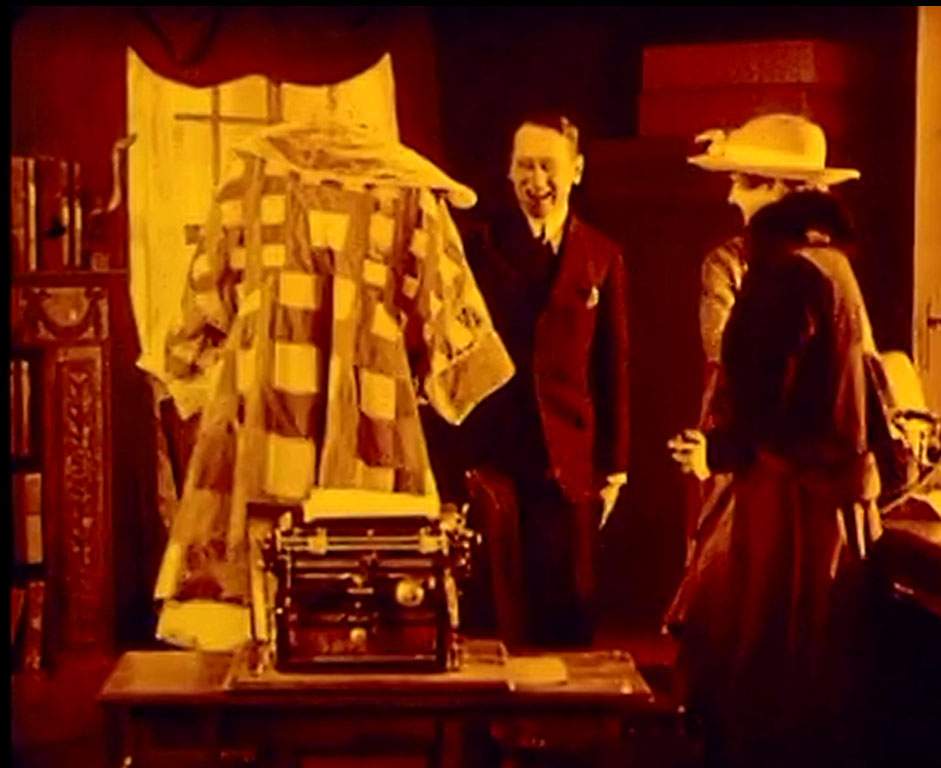
“The Checkered Raincoat” by Max Mack; Photo from the copy
Friday 28th January 2022 – Third day of the festival
After the two programs on Thursday we are presenting three programs today and we will start at 4pm with a short film program featuring films by Alice Guy-Blaché and Louis Feuillade. For the audience, but for us, it starts much earlier, because in the evening the jazz ensemble “Küspert and Colleagues” will accompany “The girl with the hat box” and late in the evening there will be the world premiere of the compositions of two students who like us will accompany the second short film program called “The Alcoholic Slapstick”. These two screenings are a great technical challenge. The students rehearsed for many hours on Thursday; Today the jazz ensemble is coming and they also want to do a rehearsal with the whole film.
After the festival I will receive an email and the director of the ensemble, Werner Küspert, will thank me for the smooth organization – in fact it was a process that had been planned in detail over several weeks in an intensive email exchange with everyone involved. When the first program starts at 4 p.m., I am happy that nothing went wrong.
Short film program Alice Guy-Blaché and Louis Feuillade
When preparing the festival, we had decided to present a dedicated program of short films dedicated to Alice Guy-Blaché and Louis Feuillade – and the focus should clearly be on Alice Guy-Blaché. I would like to take this opportunity to express a few thoughts on the reception history of Alice Guy-Blaché’s work.
Because, frankly, I have a certain problem with the announcements that have been made in recent years that Alice Guy-Blaché should be rescued from oblivion. This is because Alice Guy-Blaché has long been known to me as an important early director, as the first woman in film history, and therefore does not have to be snatched from oblivion. In addition, I ask myself regarding many screenings of silent films, in which the supposed oblivion of the directors, the screenwriters and the actors is operated on, especially in American films, whether it is not simply a rather somewhat worn out PR strategy. – According to the motto: I, we, deserve the credit of having snatched any person from the darkness of oblivion. This PR strategy is used particularly frequently at silent film screenings in the USA by the organizers there, but also by scientists.
But I admit that my point of view can be more or less subjective. At least it strikes me that the number of publications about Alice Guy-Blaché has increased significantly in recent years – and that’s a good thing. It is possible that every young generation of film scholars will have to rediscover certain aspects of film history – for themselves – and readjust or relativize the weighting of some dominant figures in film history compared to people who tend to recede into the background. This phenomenon is well known to me from the history of literature. Not only authors, even entire epochs experience a re-evaluation with a certain regularity. For the still young historiography of cinema and film, this is a development, so to speak, that the historiography did not yet know..
Back to my very personal history of the reception of Alice Guy-Blaché. Perhaps I did notice the appearance of the German translation of her biography and then also looked at the second volume of the Anthologie du Cinéma, which contains a long article by Francis Lacassin on Louis Feuillade but gives very few references to Alice Guy-Blaché?
NB: Here is a link to the ZEIT’s review of the German translation of Alice Guy-Blaché’s autobiography after it was published in 1981.
I have since discovered that the ten-volume Anthologie du Cinéma, which has been published in France since the 1960s, does not contain a contribution to Alice Guy-Blaché. And that is an irreparable omission. This is truly a film history written by men, which definitely needs to be changed. In the foreseeable future I will be presenting a longer article here on Sinn-und-Cinema about a German screenwriter who, in a certain respect, also became a victim of male film historiography. However, a feminist film historiography should not fall into the opposite direction and then offer a feminist ideologized historiography.
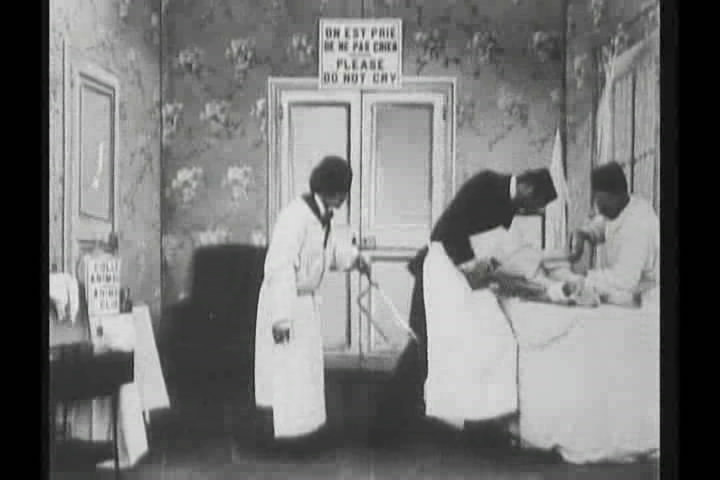
“Chirurgie fin de siècle” by Alice Guy-Blaché
We don’t want to forget the performance. We arranged the film program chronologically; we showed the films of Louis Feuillade, significantly fewer in number than those of Alice Guy-Blaché, following the films of the “first woman in film history”, as she is now often called.
I was concerned that the program might be a little tiring for the audience. Luckily, the chronological sequence turns out to be correct. It can be seen that the films have matured, were no longer just photographs of showmen, etc., but that dramaturgical means were developed and used. And then also just good subjects, above all the very funny film “La femme collante”, which I gave the German title “Die klebrige Frau” (The sticky woman).
It turns out that the program is not boring at all. The opposite occurs, and that’s largely thanks to Richard Siedhoff’s energetic, forward-moving music. He is in Karlsruhe for the first time and will certainly come back more often. His accompaniment on the piano gives some of the comedies even more speed, even more humor. A captivating, inspiring performance!
Friday, second program: “The girl with the hat box”
Films by Boris Barnet are always a highlight of every festival. This has to do with Barnet’s ability to create comical characters, plots and situations, which can hardly be overestimated. We are in the period of the so-called “New Economic Policy” (NEP), during which there was a phase of economic and political liberalization in the Soviet Union. The film severely criticizes the woman who runs a hat shop in Moscow and her husband, who is evidently “henpecked”. They cheat on young Natascha (Anna Sten), who brings her home-made hats to Moscow from the village where she lives with her grandfather. As lower petit-bourgeois types, the owner of the hat shop and her husband told the socialist property management that Natascha and her husband, who doesn’t even exist, would live in a room with them. On her journey to Moscow, Natascha is disturbed by a man sleeping in the luggage compartment above her, who also kicks her hat box. Ilja, the young man (I. Koval-Samborski) travels to Moscow to study there. And then there’s the railway ticket clerk, played by Vladimir Fogel, madly in love with Natascha.
This ensemble of figures alone guarantees a turbulent plot, which really gets going when it turns out that the lot that the man gave to the hat shop owner Natascha instead of the money for her hats actually won, and the property management also won the man Natascha wishes to see. In her distress, Natascha turns to Ilja, whom she has met again, and what has to happen comes about…
Werner Küspert and colleagues accompany the film with harmonious music, although I have to admit that my attention was so drawn to the film that I can hardly say more about the music.
So, although the film Barnets is clearly critical of the petit-bourgeois characters of the milliner and her idle husband, with all their bourgeois and decadent demeanors, the film did not receive adequately positive reception after its premiere; no, it was criticized for not being sufficiently socialist, its quality was misjudged, and the film was not given a great future. How nice that the communist cultural criticism was wrong.
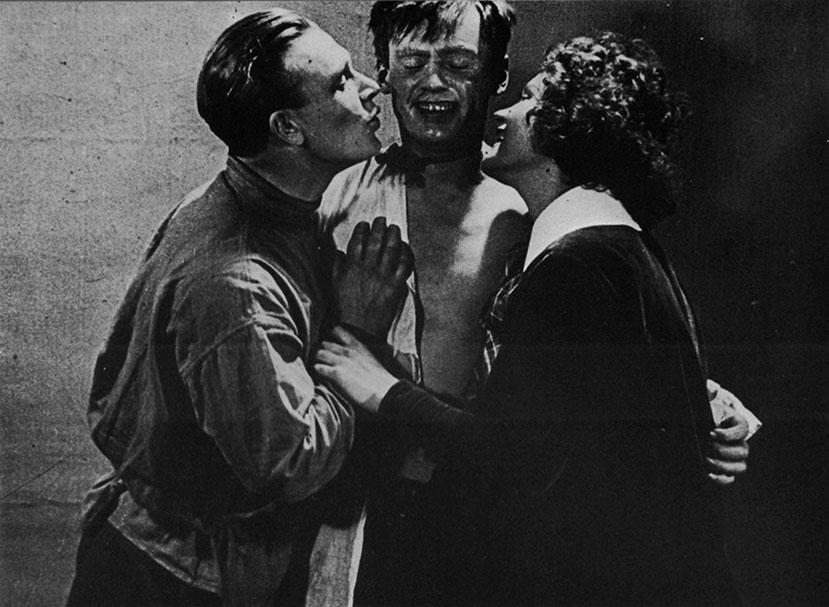
Boris Barnet, The Girl with the Hatbox (1927)
Friday, Third Program: The Alcoholic Slapstick
A short film program
I have already explained how this program came about in the program brochure and therefore do not want to repeat it here. All of the films in the program were alcohol-themed, and starting with a relatively simple slapstick film starring the lesser-known Billy Bletcher, who portrayed the “problems” of drinking during the Prohibition era, the program was progressively built around culminating in Chaplin’s The Cure.
At a previous performance many years ago, the audience “freaked out” completely; Unfortunately, it doesn’t happen this time and, unfortunately, it has to be said, it’s probably due to the musical accompaniment.
We dared a special experiment. After many efforts, we managed to get support from the Riemschneider Foundation in Karlsruhe. However, the conditions were somewhat special: the Riemschneider Foundation agreed to provide two scholarships for students at the Karlsruhe University of Music; the two scholarship holders should be named by the music academy and the scholarships should then be paid out directly via the music academy.
Ultimately, we had no influence on the choice of the two students and the music they would compose for the accompaniment. The two students Natalia Martin Barroso Garcia and Nicolas Mitschke were named by Prof. Damon Lee and composed music that was partly played live, partly came from a laptop and was therefore pre-composed. The students mainly learn composition or film music for current films, and that’s what the music sounds like. It doesn’t really meet the silent films, and is often far too powerful. And it turns out that music for comedies and slapsticks seems to be particularly difficult. Often the music seems too dramatic to me, sometimes I think I’m in the performance of a horror film as soon as I close my eyes. By the way: this is a tried and tested way of me testing a musical accompaniment. If I still have the film in my head with my eyes closed – then it’s ok. No, here the film’s images are gone immediately.
I don’t want to blame the two students; the accompaniment of silent films is probably not revealed ad hoc; I hope they both learned something and had some fun. Prof. Damon Lee seems very satified.
We would actually have wished to be able to offer a workshop led by one of the well-known silent film musicians with the support of the Riemschneider Foundation – but unfortunately this was not possible.
On the one hand, we finally got a “foot in the door” at the Riemschneider Foundation; on the other hand, it’s a bit of a shame for this absolutely entertaining and enjoyable program. None of the members of the jury, which decides on the allocation of funds to projects at the foundation, came.
Fourth and fifth day: see part 2 of the diary
Josef Jünger
Photo title: Charles Chaplin and Eden Purviance in “The Cure” by Charles Chaplin.
